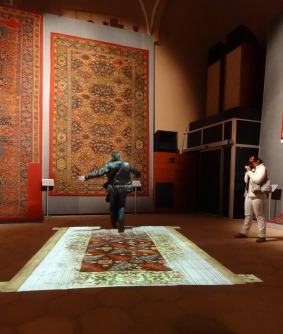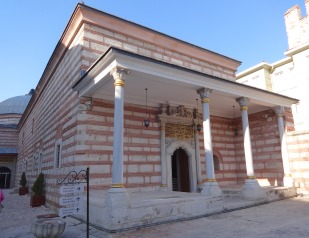Sadly, the İstanbul Carpet Museum that opened in 2013 did not reopen after the Covid pandemic and the conversion of Ayasofya back into a mosque. The suggestion is that some of the carpets will be rehoused in a museum near the Süleymaniye Cami but no date has been announced.
Opening hours: 8am-4pm
Closed: Mondays
Ticket price: Free until 1 December 2013
Location: İmaret to rear of Ayasofya, corner of Söğükçeşme Sokağı
Contacts: www.halimuzesi.com, tel: 0212-512 6993
In some ways İstanbul’s Carpet Museum should really be called the Divriği Ulu Cami Museum since many of the pieces dating from the 15th to 19th centuries once used to grace the contents of the floor the World Heritage Site isolated in deepest Anatolia near Sivas. Other pieces come from İstanbul’s Süleymaniye Cami although the only precisely dateable carpet was made for the floor of the Sultanahmet Cami (Blue Mosque) in 1826. One of the very finest pieces was an Uşak carpet woven to lie on the floor of the Eski Cami in Edirne.
The museum contains a large board illustrating the motifs to be found on the carpets although inidvidual pieces are rather underwhelmingly described (I suspect this may slowly improve). Large illustrations reproduce famous Western paintings that include respresentations of oriental carpets and that led to some of them being described as Holbein or Lotto carpets. Most impressively a painting that is reproduced all over town, Jean Leon Gerome’s 1887 The Carpet Market, has been blown up to life-size, then animated to suggest that it’s actually taking place.
The museum is housed in the İmaret (Soup Kitchen) added to Ayasofya in 1742-43 during the reign of Sultan Mahmud I.
The first gallery, with the oldest (14th and 15th century) and most damaged pieces, is housed in what was originally the dark and lengthy dining hall, while the cookhouse (aşhane) houses the second gallery while retaining some of its original features such as the raised baking areas, the tandır (pit) oven and a trough for washing items.
The third and finest gallery contains the impressive floor-to-ceiling length Uşak carpets inside what was once a bakery (fodlahane) for making bread to give to the poor. The ovens still survive although most people will be too distracted by the novelty of a panel on the floor that acquires a carpet pattern as you walk over it to notice.
The space in the three rooms is relatively limited so it remains to see how well it will cope with the crowds of summer but I came away wishing I could have had the chance to see TUrkey’s great mosques in the days when their floors were still covered in magnificent hand-made carpets like these.
Before you leave the courtyard take a look at the rather battered circular building attached to the body of Ayasofya.This was the Byzantine Skeuophylakion, designed as a repository for items used during church services with brick shelves set into its walls. It dates back perhaps to the 6th, maybe even to the 4th century. In Ottoman times it was used as a depot-larder for the items needed for the soup kitchen, then from the 19th century onwards as an archive.
Look back, too, at the large baroque-style entrance to the courtyard which features calligraphy by Beşir Ağa and verses by Nimetullah Efendi.
Bitten by the carpet bug? Then Ankara’s fine Carpet Museum (Vakıflar Eserleri Müzesi) is bigger and better than İstanbul’s.


